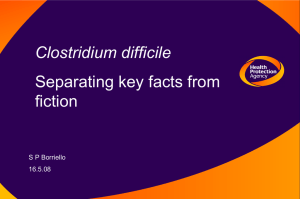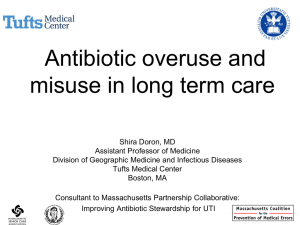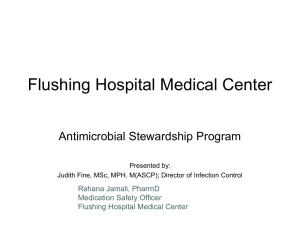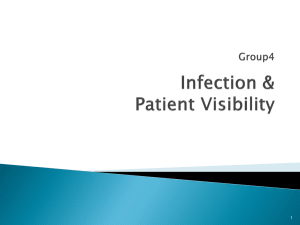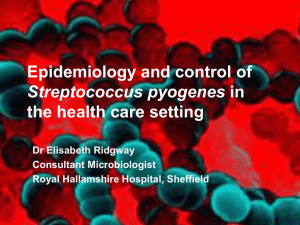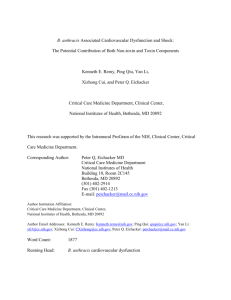PowerPoint
advertisement
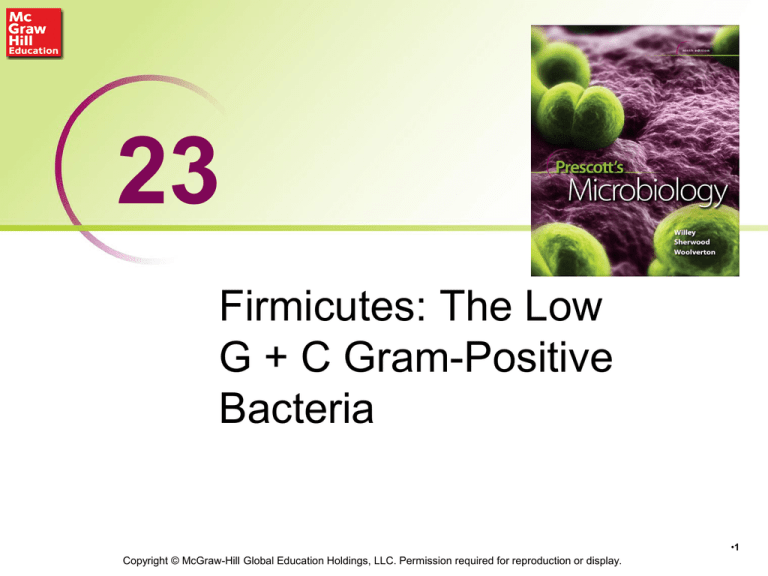
23 Firmicutes: The Low G + C Gram-Positive Bacteria •1 Copyright © McGraw-Hill Global Education Holdings, LLC. Permission required for reproduction or display. Genus Clostridium… • Great practical importance – food spoilage through the Strickland reaction (oxidation and reduction of amino acids to organic acids) – industrial production of butanol – toxin production (botulinum toxin) – endospore formers •2 Important Species of Clostridium • C. botulinum – food spoilage (especially canned foods); botulism • C. tetani – tetanus • C. perfringens – gas gangrene, foodborne illness • C. difficile – important nosocomial infection – post antibiotic infection (CDAD), pseudomembranous colitis • C. acetobutylicum - manufacture of butanol •3 Botulism • Caused by Clostridium botulinum, an obligately anaerobic, endospore-forming, Gram-positive rod – on Select Agent List (agents that pose a severe threat – CDC) • Most common source of infection is insufficiently heated home-canned food – endospores not killed, then germinate and produce toxin – if food inadequately cooked, toxin remains and causes disease •4 Botulism • Botulinum toxin – neurotoxin that binds to synapses of motor neurons • Diagnosis – restricted to reference laboratories – demonstration of toxin in patient’s serum, stool, or vomitus or C. botulinum in stool cultures •5 Botulism • Infant botulism (most common form) – endospores ingested, germinate, reproduce, and produce exotoxin (stomach not acidic) – constipation, listlessness, general weakness, and poor appetite; death may result from respiratory failure • Treatment, prevention and control – symptomatic/supportive therapy and administration of antitoxin – safe food processing practices and not feeding honey to babies under one year of age •6 Tetanus • Caused by Clostridium tetani – anaerobic, Gram-positive spore-former • endospores found in soil, dust, hospital environments, and mammalian feces – produces tetanospasmin in low oxygen tension environments • causes prolonged muscle spasms – also produces tetanolysin, a hemolysin • Portal of entry – skin wounds (puncture wounds most susceptible) •7 Tetanus • Clinical manifestations – early in disease – tension or cramping and twisting of skeletal muscles and tightness of jaw muscle – advanced disease – trismus (“lockjaw”), characteristic facial expressions, board-like rigidity of trunk, tonic convulsions, and backward bowing of back – death usually results from spasms of diaphragm and intercostal respiratory muscles •8 Tetanus • Diagnosis – clinical history of wound infection and muscle stiffness • Treatment, prevention, and control – antibiotic therapy and treatment with antitoxin – active immunization with toxoid (DPT vaccine), and proper care of wounds contaminated with soil, prophylactic use of antitoxin •9 Gas Gangrene or Clostridial Myonecrosis • Most commonly caused by Clostridium perfringens – Gram-positive, spore-forming rod – produce gas gangrene, a necrotizing infection of skeletal muscle or clostridial myonecrosis – secretes toxin and tissue damaging enzymes • Transmitted by contamination of injured tissue by spores from soil or bowel microbiota •10 Gas Gangrene • Clinical manifestations – severe pain, edema, drainage, muscle necrosis • Diagnosis – recovery of appropriate clostridial species and characteristic disease symptoms • Treatment, prevention, and control – surgical debridement, administration of antitoxin, antibiotic therapy, and hyperbaric oxygen therapy – prompt treatment of all wound infections and amputation of limbs •11 Antibiotic-Associated Colitis (Pseudomembranous Colitis) • Clostridium difficile (C. difficile associated diarrhea – CDAD) – uncomplicated diarrhea – pseudomembranous colitis • viscous collection of inflammatory cells, dead cells, necrotic tissue, and fibrin that obstructs the intestine – toxic megacolon • inflammation resulting in intestinal tissue death •12 Clostridium difficile • Anaerobic spore forming bacillus found in the intestines of some healthy people – numbers are kept in check by other normal intestinal microbiota – excessive antibiotic use eliminates normal microbiota and allows C. difficile to overgrow • most common are amoxicillin, ampicillin, clindamycin, cephalosporins – increasing due to use of hand sanitizers •13 C. difficile Virulence Factors • C. difficile multiplies and produces toxins – toxin A (enterotoxin causing diarrhea) – toxin B (cytotoxin kills cells) • Inflammation, diarrhea, fever, nausea, cramping • Most common cause of diarrhea in hospitalized patients • Treatment is with antibiotics •14 Genus Bacillus • Motile, peritrichous flagella, usually aerobic, catalase positive • Various species produce antibiotics • Bacillus subtilis is type species – Gram-positive, facultative anaerobe – soil-dwelling, spore forming – may develop biofilms •15 Bacillus subtilis • Used as model organism for – gene regulation, cell division, quorum sensing, cellular differentiation • Genome was one of first to be sequenced – families of genes expanded by gene duplication – 18 genes for sigma factors – 10 integrated prophages or remnants of prophages •16 Other Important Species of Bacillus • B. cereus – food poisoning • B. anthracis – anthrax • B. thuringiensis and B. sphaericus – used as insecticide for years •17 Anthrax • Caused by Bacillus anthracis (Select Agent) – Gram-positive, aerobic, endospore-forming – endospores viable in soil and animal products for decades – plasmid encodes genes for anthrax toxin • Transmitted by direct contact with infected animals or their products – portal of entry determines form of disease • Potential bioterrorism agent •18 Anthrax Virulence • B. anthracis evades immune system by – capsule which inhibits phagocytosis – synthesis of complex exotoxin • protective antigen – forms hole for entry of other toxins • edema factor – fluid release and edema • lethal factor – inhibits cytokine production – macrophages die, release toxic contents leading to septic shock, death •19 Cutaneous Anthrax • Infection through cut or abrasion of skin • Clinical manifestations – 1 to 15 day incubation – skin papule that ulcerates (eschar), headache, fever, and nausea • Antibiotic therapy •20 Pulmonary and Gastrointestinal Anthrax • Pulmonary anthrax – woolsorter’s disease – inhalation of endospores – resembles influenza – if bacteria reach the bloodstream, usually fatal • Gastrointestinal anthrax – ingestion of endospores •21 Anthrax • Diagnosis – presumptive ID in sentinel labs of Laboratory Response Network (LRN) • Gram-stained smear of skin lesion, cerebrospinal fluid or blood; also growth and biochemical characteristics of culture – confirmatory diagnosis by PCR and serology • Treatment, prevention, and control – antibiotic therapy and symptomatic/supportive therapy – immunization of animals and persons at high risk •22 Genus Sporosarcina • Only known endospore - former that has coccoid and not rod shape • Tolerates pH up to 10 – degrades urea to ammonia and carbon dioxide • Isolated from agricultural soils where animals urinate •23 Family Staphylococcaceae • 5 genera, includes Staphylococcus • Facultatively anaerobic, nonmotile, Gram-positive cocci • Usually form irregular clusters • Normally associated with warm-blooded animals in skin, skin glands, and mucous membranes •24 Members of Staphylococci • S. aureus – coagulase positive, pathogenic • S. epidermidis – coagulase negative, less pathogenic but nosocomial opportunists • Many pathogenic strains are slime producers • Teichoic acid and peptidoglycan contribute to pathogenicity •25 Staphylococcal Diseases • Caused by members of the genus Staphylococcus – Gram-positive cocci, occurring singly, in pairs, tetrads, or grape-like clusters – facultative anaerobes and usually catalase positive – normal inhabitants of upper respiratory tract, skin, intestines, and vagina •26 Staphylococcal Diseases • Harbored by asymptomatic carriers or active carriers (have the disease) – spread by hands, inanimate objects or expelled by respiratory tract, or through blood • May produce disease in almost every organ and tissue • Immune compromised most at risk •27 Virulence Factors of Staphylococci • Exotoxins and enzymes involved in invasiveness • Toxin genes may reside on plasmids and on chromosome • Examples – enterotoxin – food intoxication – bacteremia and abscess formation •28 •29 Staphlococcus aureus • Most important human staphloccoccal pathogen – e.g., abscesses, boils, wound infections, pneumonia, toxic shock syndrome – major cause of common food poisoning • Virulence factors – coagulase which causes blood plasma to clot – the toxin β-hemolysin lyses cells •30 Staphylococcal Food Poisoning • Results from ingestion of improperly stored or cooked food (e.g., ham, processed meats, chicken salad, ice cream, and hollandaise sauce) in which Staphylococcus aureus has grown and released enterotoxin • Bacteria produce heat-stable enterotoxins in food – properly cooking the food will not destroy toxin; intoxications can result from thoroughly cooked foods • Symptoms include abdominal pain, cramps, diarrhea, vomiting, and nausea •31 Staphylococcal Food Poisoning • Diagnosis – based on symptoms or laboratory identification of bacteria from food – enterotoxins can be detected in foods by animal toxicity tests • Treatment, prevention, and control – fluid and electrolyte replacement – avoidance of food contamination, and control of personnel involved in food preparation and distribution •32 Staphylococcal Scalded Skin Syndrome (SSSS) • Caused by strains of S. aureus that carry a plasmid-borne gene for exfoliative toxin (exfoliatin) • Epidermis peels off revealing red area underneath • Diagnosis – isolation/identification of Staphylococcus involves commercial kits •33 Staphylococcal Scalded Skin Syndrome (SSSS) • Treatment, prevention, and control – isolation and identification based on catalase test, coagulase test, serology, DNA fingerprinting, and phage typing – antibiotic therapy • many drug-resistant strains – personal hygiene, food handling, and aseptic management of lesions •34 Toxic Shock Syndrome (TSS) • Caused by S. aureus strains that release toxic shock syndrome toxin and other toxins • Some cases occur in females who use superabsorbent tampons • Disease results from body’s response to staphylococcal superantigens • Clinical manifestations – low blood pressure, fever, diarrhea, extensive skin rash, and shedding of skin •35 Staphylococcal Lesions • Localized abscess – S. aureus infects a hair follicle, tissue necrosis results – coagulase is produced forming a fibrin wall around lesion, limiting spread – liquefaction of necrotic tissue in center of lesion occurs; abscess spreads – may be a furuncle (boil) or carbuncle – bacteria may spread from area via lymphatics or bloodstream •36 Methicillin-Resistant Staphylococcus aureus (MRSA) • S. aureus isolates that are resistant to β-lactam antibiotics (penicillins and cephalosporins) • Community acquired (CA) – MRSA – healthy individuals not recently hospitalized – associated with serious and fatal infection – may also be acquired in health care setting •37 S. aureus Antibiotic Resistance • Methicillin-resistant S. aureus (MRSA) and Vancomycin resistant S. aureus (VRSA) – among most threatening antibiotic resistant • VRSA may have no treatment – obtained from genetic elements received from other organisms – virulence factors also acquired from mobile genetic elements •38 Slime Producers (SP) • Produced by pathogenic strains of Staphylococcus – a viscous extracellular glycoconjugate – allows bacteria to adhere to smooth surfaces and form biofilms – Inhibits neutrophil chemotaxis, phagocytosis, and antimicrobial agents •39 Staphylococcus epidermidis • Common skin resident • Sometimes responsible for endocarditis and for infections of patients with lowered resistance – e.g., wound infections, surgical infections, and urinary tract infections •40 Genus Listeria • Wide distribution in nature - common in decaying matter • L. monocytogenes pathogen of humans and animals – listeriosis - food-borne infection – especially dangerous to pregnant women, the fetus and infant, and compromised individuals (90% of cases) – 1600 cases/yr in US, 3rd leading cause of fatalities associated with food-borne illnesses – grows at refrigeration temperatures – associated with many foods that are not cooked, i.e lunch meats, cheeses, sprouts, fruits •41 Order Lactobacillales • Also called lactic acid bacteria (LAB) • Morphologically diverse – nonsporing – usually nonmotile • Ferment sugars for energy – lack cytochromes – fastidious • Contains several important genera •42 Genus Lactobacillus • Widely distributed in nature – on plant surfaces – in dairy products, meat, water, sewage, beer, fruits, and other materials – normal flora of mouth, intestinal tract, and vagina • usually not pathogenic •43 Importance of Lactobacilli • Fermented products – vegetable products (sauerkraut, pickles, and silage) – beverages (beer, wine, juices, milk) • • • • • Sour dough bread Swiss cheese and other hard cheeses, yogurt Sausages L. acidophilus – sold as probiotic agent Food spoilage – beer, wine, milk, meat •44 Importance of Leuconostoc • Wine production • Production of sauerkraut and pickles • Production of buttermilk, butter, and cheese • Synthesis of dextrans (L. mesenteroides) • Involved in food spoilage – tolerate high sugar concentrations – grow in heavy syrup •45 Families Streptococcaceae and Enterococcaceae • Chemoheterotrophic, mesophilic, nonsporing cocci, usually nonmotile • Fermentative only • Aerotolerant and anaerobic • Groups – enterococci – lactococci – streptococci •46 Three Groups of Streptococci • Pyogenic (pus producing) streptococci – e.g., S. pyogenes – streptococcal sore throat, acute glomerulonephritis, and rheumatic fever • Oral streptococci – e.g., S. mutans – dental caries • Other streptococci – e.g., S. pneumoniae – lobar pneumonia and otitis media •47 Streptococcal Diseases • Caused by strep, group of Gram-positive bacteria – Streptococcus pyogenes • one of most important pathogens • group A β-hemolytic streptococci (GAS) – virulence factors • extracellular enzymes that break down host molecules • streptokinases – dissolve clots • streptolysin O and S – kill host leukocytes • capsules and M protein for attachment •48 Streptococcal Diseases • Streptococcus pyogenes – widely distributed, some carriers – common infection “Strept throat” – transmission • respiratory droplets, direct or indirect contact • Diagnosis – based on clinical and laboratory findings – rapid diagnostic tests available •49 Streptococcal Pharyngitis • • • • Common infection called strep throat Spread by droplets of saliva or nasal secretions Infection in throat (pharyngitis) or tonsils (tonsillitis) Signs and symptoms of disease not diagnostic because many viral infections have similar presentation • Physical manifestations – redness, edema, exudate in 50% and lymph node enlargement in throat •50 Additional Streptococcal Diseases • Contact superficial cutaneous diseases – include cellulitis, impetigo, and erysipelas • Invasive diseases – may reach underlying muscle •51 Superficial Cutaneous • Cellulitis – diffuse, spreading infection of subcutaneous tissue – redness and swelling • Impetigo – also caused by Staphylococcus aureus – superficial cutaneous infection commonly seen in children – crusty lesions and vesicles surrounded by red border • Erysipelas – acute infection of dermal layer of skin – red patches that may occur periodically at same site for years •52 Invasive Streptococcal Infections • Caused by certain virulent strains of S. pyogenes • Rapidly progressive – carry genes for exotoxins • superantigens (Select Agent) • tissue-destroying protease •53 Invasive infections • Clinical manifestations – necrotizing fasciitis (“flesh eating”) • destruction of sheath covering skeletal muscle – myositis • inflammation and destruction of skeletal muscle and fat tissue – toxic shock-like syndrome (TSLS) • precipitous drop of blood pressure, failure of multiple organs, and high fever •54 Streptococcal Pneumonia • Opportunistic pathogen – caused by one’s own normal microbiota • Caused by Streptococcus pneumoniae – produces polysaccharide capsule and a toxin – rapidly multiplies in alveolar spaces • Disease only occurs in individuals with predisposing condition •55 Poststreptococcal Diseases • Glomerulonephritis (Bright’s disease) and rheumatic fever • 1–4 weeks after an acute streptococcal infection • Nonsupportive (nonpus-producing) • Most serious problems associated with streptococcal infections in U.S. •56 Streptococcal Pneumonia • Primary virulence factor – capsule of hyaluronic acid that is antiphagocytic – allows rapid multiplication of bacteria in alveolar spaces • Release of pneumolysin – destroys host cells – alveoli fill with blood cells and fluid •57 Streptococcal Pneumonia • Diagnosis – chest X-ray, gram stain, culture, and tests for metabolic products • Clinical manifestations – abrupt onset of chills, hard labored breathing, chest pain, and rust-colored sputum • Treatment, prevention, and control – antibiotic therapy • resistant strains have appeared – immunization and treatment of infected persons •58 Streptococcal Diseases • Other diseases are – sinusitis, conjunctivitis, otitis media – bacteremia, meningitis • Treatment, prevention, and control – most treated by antibiotic therapy – Pneumovax capsular vaccine •59 Glomerulonephritis • Inflammatory disease of renal glomeruli – a type III hypersensitivity • Clinical manifestations – edema, fever, hypertension, and hematuria – may spontaneously heal or may become chronic • Diagnosis – clinical history, physical findings, and confirmatory evidence of prior streptococcal infection • Treatment, prevention, and control – antibiotic therapy (to kill residual bacteria), otherwise no specific therapy •60 Rheumatic Fever • Autoimmune disease involving heart valves, joints, subcutaneous tissues, and central nervous system • Clinical manifestations – vary widely, making diagnosis difficult • Treatment, prevention, and control – therapy directed at decreasing inflammation and fever, and controlling cardiac failure – treatment with salicylates and corticosteroids •61 Genus Streptococcus • Hemolysis patterns used in Lancefield grouping – alpha (a) – hemolysis • incomplete lysis of red blood cells • seen as greenish zone around colony on blood agar – beta (b) - hemolysis • complete lysis of red blood cells • seen as clear zone around colony on blood agar •62 Hemolysis on blood agar Beta hemolytic (complete) Alpha hemolytic (partial) Gamma hemolytic (none) •63 Group B Streptococcal Disease • Caused by Gram-positive Streptococcus agalactiae or Group B streptococcus (GBS) • Common cause of neonatal and newborn diseases such as sepsis, meningitis, and pneumonia • Transmitted directly from person-to-person with many people being transient carriers; vagina may be source for newborns •64 GBS • Clinical manifestations – early onset disease • presents within first few hours after birth • may be severe meningitis or death – late onset disease - rare • Diagnosis – Gram-positive, beta-hemolytic, streptococcal bacteria growth from cultures of otherwise sterile body fluids • Treatment, prevention, and control – detect pregnant carriers – antibiotics •65 Important Enterococci and Lactococci • Enterococcus faecalis – normal biotic in gastrointestinal tract – opportunistic pathogen (urinary tract infections and endocarditis) – Used as an indicator organism in natural waters, ocean, brackish water, frozen food • Lactococcus lactis – production of buttermilk and cheese •66

